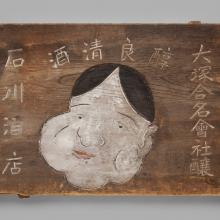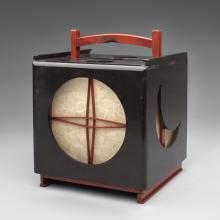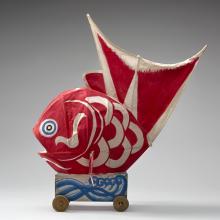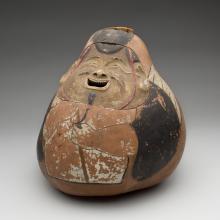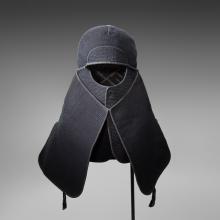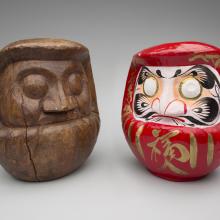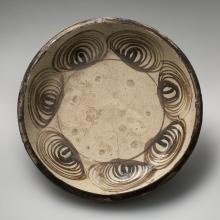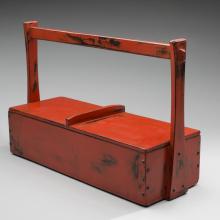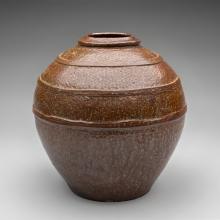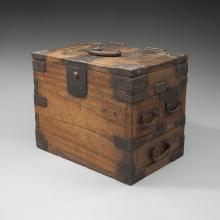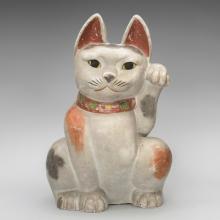International Terminal












Saké shop sign c. 1800
Japan
wood, pigment
Gift of Maurice M. Kawashima
Mingei International Museum
2010-06-001
L2015.0601.047
On crowded city and village streets, shopkeepers had to compete for their customers’ attention. Wooden shop signs (kanban) with pleasing designs played an important role in catching the attention of people passing by and attracting customers. Many signs took the shape of the items for sale. This wooden saké shop sign from the Meiji period (1868–1912) proudly announces the Ishikawa Saké Shop and further reads: “Beautifully blended pure sake.” As further enticement, it uses a culturally popular smiling female face: Otafuku or Okame, the Goddess of Mirth, to entice potential patrons.
Lantern c. 1800s
Japan
paper, wood
Gift of Delmar E. Kolb
Mingei International Museum
2008-26-002A-B
L2015.0601.026a,b
A variety of stationary and mobile Japanese lanterns for indoor- and outdoor-use have long been an important part of everyday life in Japan. Fuel was generally wax or oil. When paper is applied to a frame of wood or metal enclosing an oil dish to make a light chamber, the result is an andon. These framed paper lanterns are noted for their elegance and the simplicity of their angular design. The use of papered sliding doors (shoji), which diffused the light source in Japanese interiors, may have influenced the development of Japanese-style lighting. In the daytime, these doors provided a shield against the harsh rays of sunshine, but still permitted adequate light into the interior. The same principle is applied with andon. They shield the bright flame and elegantly diffuse the light.
Portable paper lanterns called chochin came into use during the Muromachi period (1338–1573) and subsequently were produced in a great many styles. Many of these have an accordion-like appearance so that they can be easily folded when not in use.
This type of small, portable lamp could be used two ways. When the paper and wood frame is placed inside the box-like cover, light shines through the rectangular opening on the front, through the crescent moon cutout. When the cover is removed and placed under the papered frame as a base, the lamp functions as a small andon. These nightlights (ariake-andon) were intended to remain lit throughout the night.
Carp lantern 20th century
Japan
paper, wood, paint
Gift of Mary McGerity
Mingei International Museum
2005-23-001
L2015.0601.050
As an island nation, fish have long been an important part of Japanese culture. Over time, a number of fish, particularly the carp (koi) have developed important symbolic meanings in East Asia, including Japan. The carp symbolizes strength and resilience. Like salmon, carp swim upstream struggling over the rapids to spawn. Legend has it that schools of carp tirelessly worked to swim up a waterfall, one of which succeeded and was rewarded by being transformed into a dragon. Thus, the carp symbolizes worldly advancement and perseverance. Parents wish for their sons to have the bravery and drive of the carp to achieve all of their aspirations.
Fish are a popular subject for many whimsical folk toys. Like so many Japanese folk toys originally sold at temple or shrine festivals, many served as good luck charms rather than play things. Such toys were intended to invite good fortune and ward off evil. Toys such as this lantern were probably meant to instill the perseverance of the carp. Lanterns of this type date from the end of the 1800s when they were first used as decorations in summer festivals.
Charcoal caddy possibly 1800s
Japan
gourd, paint
Gift of Rumi Tamura Dover
Mingei International Museum
2003-30-005
L2015.0601.101
The tradition of using charcoal for heating, grilling, and the tea ceremony is deeply rooted in Japanese traditions and culture. As a result, the Japanese have created beautiful caddies (sumitori) to store charcoal to replenish the small fires in hibachis or braziers. This example is made from a dried gourd, though many of these containers are made of basketry. It was created by cutting an ovoid opening in the top of the large gourd, then attaching a bamboo handle. The gourd is a representation of Hotei, one of Japan’s seven gods of good fortune.
There are two different types of very pure, high-carbon Japanese charcoals: black charcoal (kuro-zumi) and white charcoal (shiro-zumi), which generate virtually no smoke or flames. The two types are achieved through different processes. Black charcoal is made from wood, typically oak, that is burned at extremely high temperatures over several days and then rapidly cooled. It burns hot enough for metal smelting and tool production. To make white charcoal, instead of firing the wood at a high temperature, it is fired at a low temperature for some time. Next, the temperature is raised; then the charcoal is quickly pulled out and covered with a white powder of ash, earth, and sand to help it cool. Chefs often prefer this long-burning charcoal when grilling foods such as eel (unagi) or chicken skewers (yakitori).
Fireman’s hood c. late 1800s
Japan
cotton
Museum purchase made possible by a gift from Jeaninne and Richard Helmstetter
Mingei International Museum
1999-20-064
L2015.0601.122
 During the Edo period (1615–1868) fires, often referred to as “the flowers of Edo” because of their frequency, posed a constant threat in urban Japan. Densely packed rows of traditional Japanese houses built of wood, bamboo, and paper with straw roofs, were extremely vulnerable to fire. At the beginning of the Edo period there was no organized system for fighting fires. This began to change, particularly after 1657, when a terrible fire known as the Great Fire of Meireki, led to more organized brigades.
During the Edo period (1615–1868) fires, often referred to as “the flowers of Edo” because of their frequency, posed a constant threat in urban Japan. Densely packed rows of traditional Japanese houses built of wood, bamboo, and paper with straw roofs, were extremely vulnerable to fire. At the beginning of the Edo period there was no organized system for fighting fires. This began to change, particularly after 1657, when a terrible fire known as the Great Fire of Meireki, led to more organized brigades.
Firemen wore thick cotton coats, the insides of which were painted with elaborate designs including folk heroes or mythical creatures such as dragons to inspire courage and bravery in firefighters. In addition to their coats, firemen wore cotton hoods and hand protectors. They then doused these ensembles in water, which made the clothing much heavier, but provided better protection from flames.
A flag (matoi) signaled the presence of a fire to surrounding brigades to quickly come forth with water. During the Edo period, neighboring properties were commonly torn down in an attempt to prevent fires from spreading. Tools included fire hooks or axes to pull down burning or dangerous parts of a building or drag objects away from the fire, rudimentary water pumps, which first came into use in the late 1700s, and bamboo ladders.
|
Daruma mold possibly 20th century |
Daruma figure 20th century |
This wooden figure is a mold for making hollow, papier-mâché Daruma tumble toys. Papier-mâché Darumas, which the Japanese have produced for centuries, are nearly as ubiquitous as maneki neko. Takasaki City in Gunma Prefecture northwest of Tokyo is the leading producer of Daruma dolls in Japan. Daruma is a rotund doll based on Bodhidharma, a Buddhist monk who brought Zen Buddhism to China from India or Central Asia. Daruma tumble-toys are made of hollow papier-mâché weighted with clay at the bottom so they always return to an upright position after being pushed over.
As the story is told, the doll appears legless, due to the legend that Daruma’s legs wasted away during his many intensive years of sitting in meditation, which lead to his enlightenment. Others say he is simply sitting in a zazen meditation position with his legs crossed and his arms tucked into the folds of his bright red robe. The figure’s wide staring eyes refer to the tale of Daruma cutting off his eyelids to prevent himself from falling asleep during his long period of meditation.
New, papier-mâché Darumas have blank, white eyes. This allows the purchaser to make a special wish or set a goal. When the wish or goal is made, one eye is painted; when the wish or goal is fulfilled, the second eye is painted. Once both eyes are painted, these papier-mâché figurines are commonly burned at temples at the end of the year and a new Daruma is obtained.
Votive painting of a black horse c. 1800s–early 1900s
Japan
wood, paint
Gift of Esther and Morgan Sinclaire
Mingei International Museum
2009-05-105
L2015.0601.117
In Japan, people have used votive paintings (ema)—small wooden plaques as offerings at shrines and temples—for centuries. E means “picture” or “painting” and uma means “horse,” therefore, ema literally means “horse picture.” Originally, noblemen gave horses as offerings when asking for assistance at Shinto shrines. The gift of a black horse was considered appropriate when requesting rain for the crops during a drought, whereas a white horse was suitable in case of a flood. Since only the wealthiest could afford to donate real horses, the custom was eventually altered to permit offerings of wooden horse figures and then paintings of horses.
During the Muromachi period (1338–1573), numerous subjects other than horses were illustrated on votive plaques. Ema are typically used when asking for health, wealth, protection from illness, or success in exams. Ema are also purchased to thank the deity of a shrine who has answered a prayer. On one side of the plaque are colorful images that allude to a specific wish of the person. Full-sized ema, around two-feet, were usually commissioned from a professional painter. Little ema (ko-ema) were painted in advance, in sizable quantity by itinerant folk painters employed at larger shrines and temples. Serving as both offerings for wishes and souvenirs, ko-ema were sold to those visiting shrines, especially during festivals.
A shrine or temple receiving an ema usually displayed it high on an outside wall, under the overhanging eaves of the roof. Exposed to wind and rain, ema weathered quickly and few old ones have survived in good condition.
©2015 by the San Francisco Airport Commission. All rights reserved
Horse-eye motif plate early 1800s
Japan
stoneware, glaze
Gift of Dr. Delmar E. Kolb
Mingei International Museum
2011-57-002
L2015.0601.139
Uma-no-me means “horse eye” in the sense of “bull’s-eye” a concentric-circle design, except that the horse’s eye motif is elongated. Depending on the size of the plate, five or six horse eyes form a continuous border around the undecorated central portion of an uma-no-me. Seto kilns offered these plates in large quantities in the late eighteenth and early nineteenth centuries.
For centuries, folk pottery was a necessity for many Japanese in provincial towns and cities. Unlike the ceramics made for the aristocracy and the affluent merchant classes, folk pottery was intended for daily use, during a time when industrial mass production of porcelain and stoneware did not yet exist. Craftsmen made some of the folk pottery; others were simply farmers working as part-time potters. Many of these pieces have a simple, organic beauty. Sometimes these coarse kitchen wares were made alongside refined porcelains; other pottery production centers were intended solely as folk kilns.
Utensils were made from earthenware and stoneware. Traditional shapes for utilitarian purposes include large water jars, miso or saké containers, kneading bowls, and basins. Pottery dishes, plates, and teapots were also common forms. Artisans often accented wares with a poured or running glaze. Glazes, such as black, brown, yellow, green, and white were usually subdued in color. Ash glaze, made from wood or straw, is the most ancient, but potters may also use tin, iron, and lead glazes.
Rectangular box with lid 20th century
Japan
wood, lacquer
Gift of Mary Plaisted Austin
Mingei International Museum
1997-90-054A-B
L2015.0601.077
For centuries, people have revered Japanese lacquer, a glossy coating used to waterproof and decorate wood. Employed since ancient times, by the Muromachi period (1338–1573), lacquer wares became accessible for common use and were widely sold in public markets. Such wares were typically plain, black, or red, and occasionally modestly decorated with designs painted in colored lacquer or paint. Negoro refers to a type of lacquerware in which red lacquer is applied over black. Over time, the red surface wears away exposing the black layers underneath, displaying a subtle blend of red and black.
The best work was reserved for special pieces—wine and food vessels made for weddings, New Year festivities and other important events. Because red is associated with joy and celebration in Japan, it was a popular color for these special-occasion wares.
Raw lacquer is from the sap of the sumac tree found in many parts of Japan. A sticky, poisonous substance, it can cause a skin rash with only brief contact. Lacquer requires a very humid environment in order to dry—a special wet room with extremely high humidity. However, once the pieces are dry, the lacquer is quite hard and becomes impervious to normal liquids, including alcohol and solvents. Lacquer may be used in its refined natural state for a clear finish or else with coloring agents added for an opaque, colored finish.
Stoneware jar 1967
Shimaoka Tatsuzō (1919–2007)
Japan
stoneware, slip
Gift of Martha W. Roth
Mingei International Museum
1977-14-001
L2015.0601.037
Shimaoka Tatsuzō was one of the most prominent Japanese Mingei potters of the twentieth century. As a Mingei potter, he made works for everyday use such as plates, teacups, and bowls. Shimaoka was born in Tokyo in 1919 to a family of ornamental braid makers. Rather than enter the family business, he studied industrial ceramics at the Tokyo Institute of Technology. Shimaoka felt inspired after a visit to the newly opened Japan Folk Crafts Museum, where he encountered Mingei philosophy and objects for the first time. In interviews, Shimaoka compared its effect on his future as to “rain on soil.”
Shimaoka graduated from the Tokyo Institute of Technology in 1941, served in World War II in Burma, and returned to Japan, moving in 1946 to Mashiko, a town with a tradition of pottery making located an hour north of Tokyo. He became an apprentice of Hamada Shōji, one of Mingei’s founding proponents. Inspired by the rope decoration of prehistoric Japanese Jōmon pottery, the hallmark of Shimaoka’s work was his use of rope-impressed patterning by pressing rope into the clay while it is still wet (3).
In 1950, the Government of Japan began to designate certain individuals or groups who embodied intangible national cultural values as living human treasures. In 1996, Shimaoka was designated a Living National Treasure for his unique contribution to Japanese pottery.
Sea chest 1800s
Japan
wood, iron
Museum purchase
Mingei International Museum
1983-22-001
L2015.0601.090
Sea chests were used to safeguard money, documents, and similar valuables at sea as the ship journeyed to various ports. Sea chests were commonly used during the Edo (1615–1868) and Meiji (1868–1912) periods when most trade was conducted by sea. Large ships carried domestic commerce both on the Pacific Coast and the Sea of Japan routes. Because shipping was an extremely lucrative business, many sea chests were embellished. As was typical with Japanese furnishings, the natural beauty of the unfinished wood was emphasized. The corners and seams of sea chests were carefully reinforced with metal. Sea chests had to be heavy and sturdy to withstand the rolling and pitching of rough seas. Carrying handles were provided on both sides, while the insides were often intricately fashioned with hidden compartments and other special features. The manufacture of sea chests has been traced to three main production centers, all on the Sea of Japan coast: Sakata (Yamagata Prefecture), Ogi (Sado Island), and Mikuni (Fukui Prefecture).
Maneki neko 20th century
Japan
clay
Gift of Billie L. Moffitt
Mingei International Museum
2010-04-012
L2015.0601.002
Distinctly Japanese in form and origin, since the mid-nineteenth century, maneki neko or cat figurines beckoning with a paw upraised in the Japanese gesture of drawing people forth, have served as a good luck charm in businesses and homes. These whimsical, lucky objects are believed to have the power to fulfill wishes for good fortune, prosperity, and well-being. Maneki neko are common sights in local Japanese and Chinese restaurant windows, where they silently beckon to potential customers to enter. The cat holds up its left paw in an effort to bring luck and good fortune to a business; it holds up its right paw to invite good fortune, health, and happiness into the home. Colors also have certain connotations. White represents happiness and satisfaction, while black symbolizes safety and helps to drive away evil. One of the distinctive features of many maneki neko is the bib attached to the neck. Bibs are frequently painted with classic symbols of good luck and fortune, such as coins.
By the end of the Meiji period (1868–1912), maneki neko in plaster and ceramic were being manufactured in numerous sites across the country. Maneki neko also began appearing to a lesser extent in copper, bronze, wood, stone, and iron. By the early 1900s, some of the more important manufacturing sites that made maneki neko included the celebrated Seto and Kutani porcelain kilns and the Bizen stoneware kilns.
